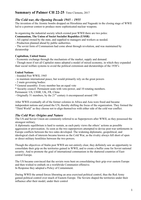Summary of Palmer CH 22-25 Timo Clemens, 2017
The Cold war, the Opening Decade 1945 – 1955
The invention of the Atomic bombs dropped on Hiroshima and Nagasaki in the closing stage of WWII
led to a postwar contest to produce more sophisticated nuclear weapons.
In organizing the industrial society which existed post WWII there are two poles:
Communism, The Union of Societ Socialist Republics (USSR)
- All capital owned by the state, and supplied to managers and workers as needed.
- Production planned ahead by public authorities.
- The soviet form of Communism had come about through revolution, and was maintained by
dictatorship
Capitalism, United States
- Economic exchange through the mechanism of the market, supply and demand.
- Though most if not all Capitalist states adopted a model of mixed economy, in which they expanded
thair social welfare systems to avoid the political extremism and dictatorships of the 1930’s
United Nations
- founded Post WWII, 1945
- to maintain international peace, but would primarily rely on the great powers
- 2 main governing bodies:
* General assembly: Every member has an equal vote
* Security council: Permanent seats with veto-power, and 10 rotating members.
Permanent: US, USSR, UK, FR, China
- Originally 51 members, by the 21st century it encompassed around 190
After WWII eventually all of the former colonies in Africa and Asia were freed and became
independent nations and joined the UN, thereby shifting the focus of the organization. They formed the
“Third World” as they choose not to align themselves with either side of the cold war conflict.
The Cold War: Origins and Nature
The US and Soviet Union are commonly referred to as Superpowers after WWII, as they possessed the
strongest military.
A diplomatic equilibrium is hard to sustain, as each party views the others’ actions as possible
aggression or provocation. As soon as the two superpowers attempted to devise post-war settlements in
Europe conflicts between the two sides developed. The widening diplomatic, geopolitical, and
ideological clash of interests became known as the Cold War, as the rivalry always fell short of open
or direct military hostilities between the two powers.
Though the objectives of Stalin post WWII are not entirely clear, they definitely saw an opportunity to
consolidate their grip on the territories gained in WWII, and to create a buffer zone for Soviet national
security. And to promote the goal of international communism in the shattered countries of East-
central Europe.
The US became convinced that the soviets were bent on consolidating their grip over eastern Europe
and then wished to embark on a worldwide Communist offensive.
In Response they adopted a Policy of Containment.
During WWII the armed forces liberating an area exercised political control, thus the Red Army
gained political control over much of Eastern Europe. The Soviets shaped the territories under their
influence after their model, under their control
1





